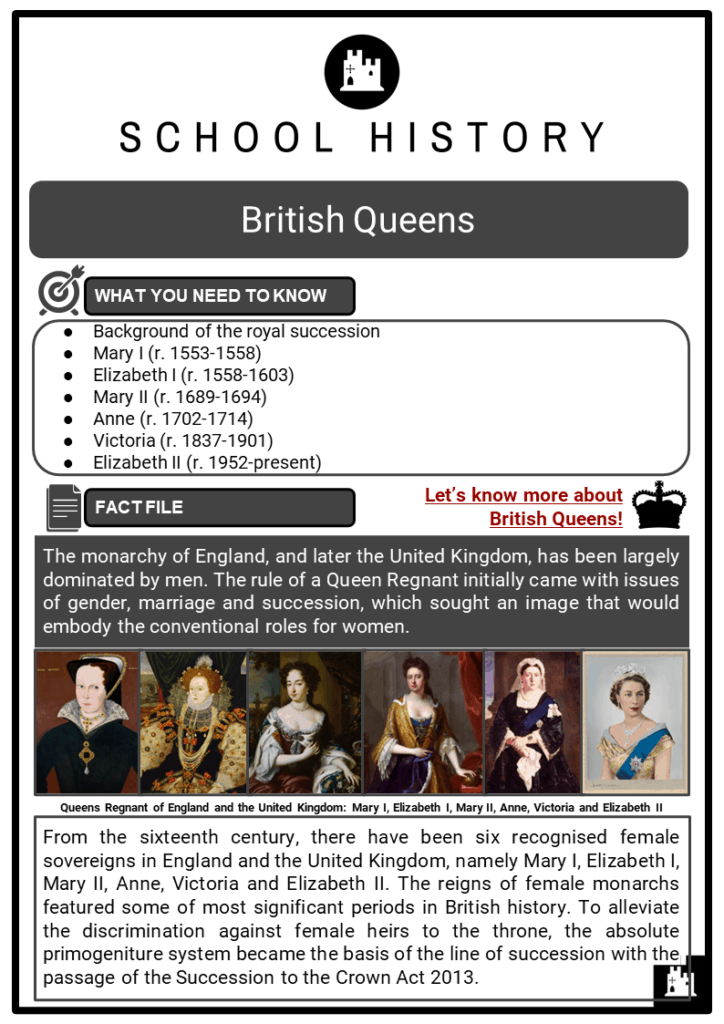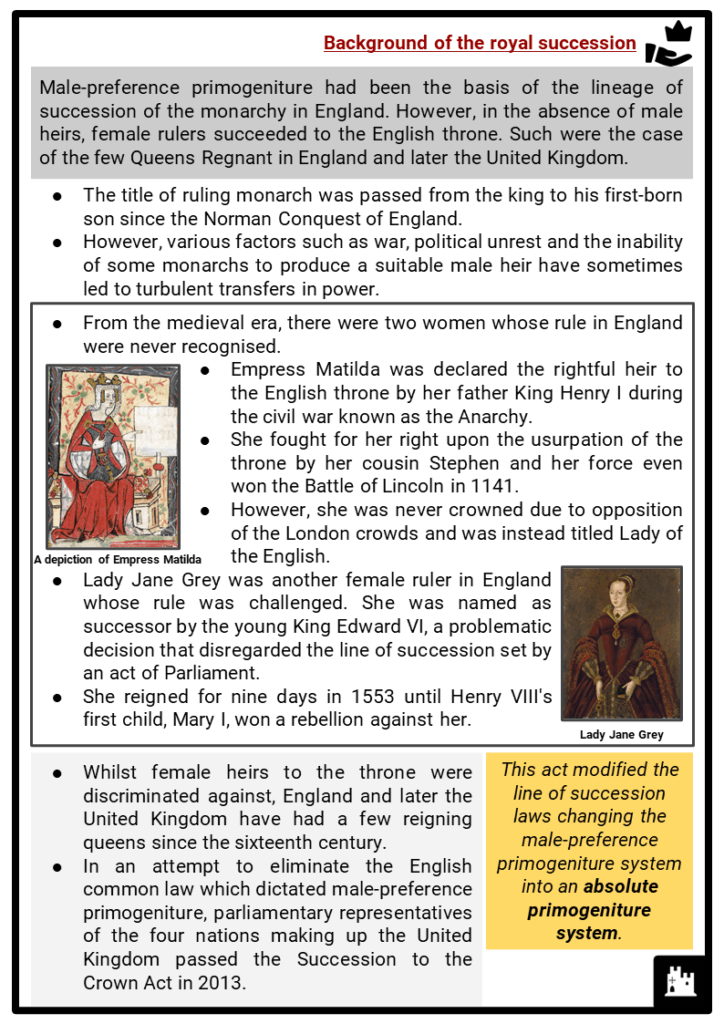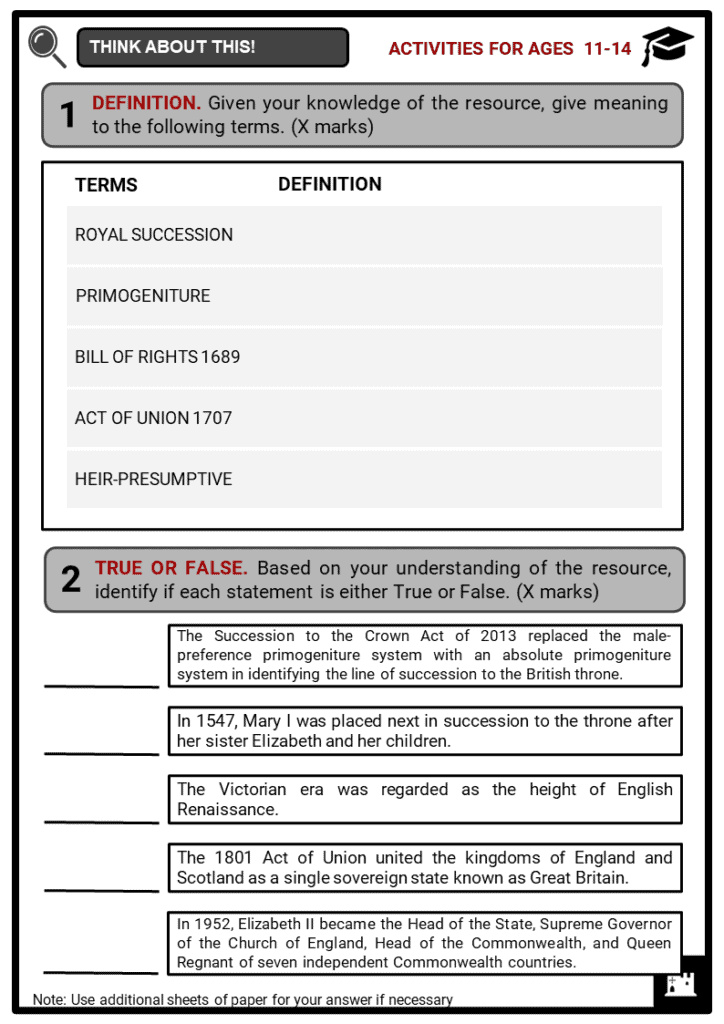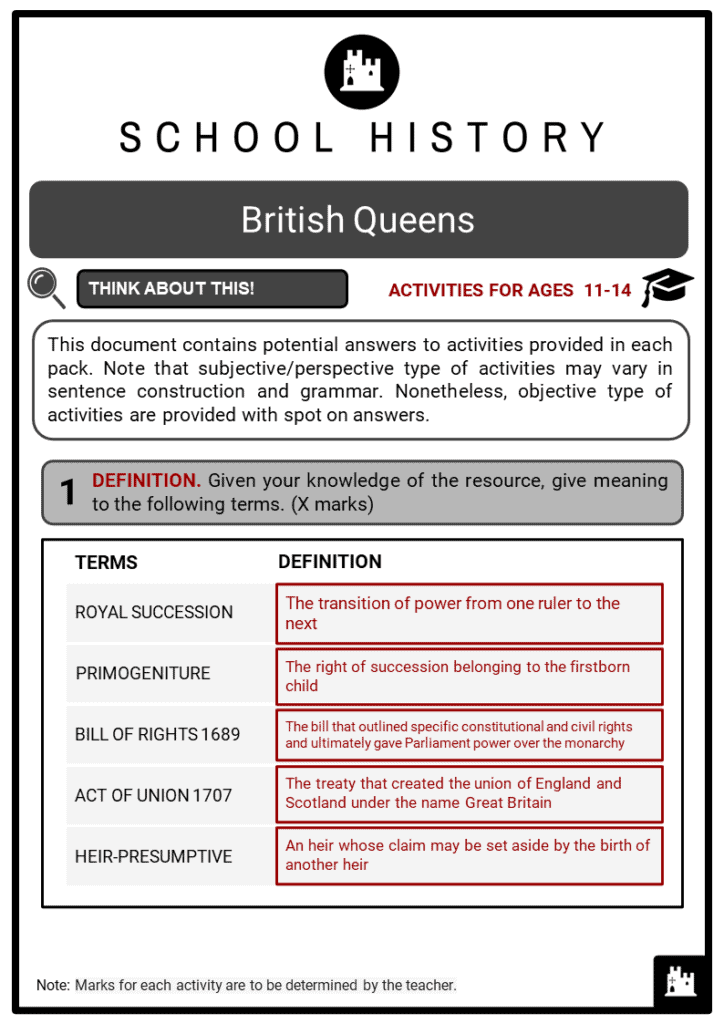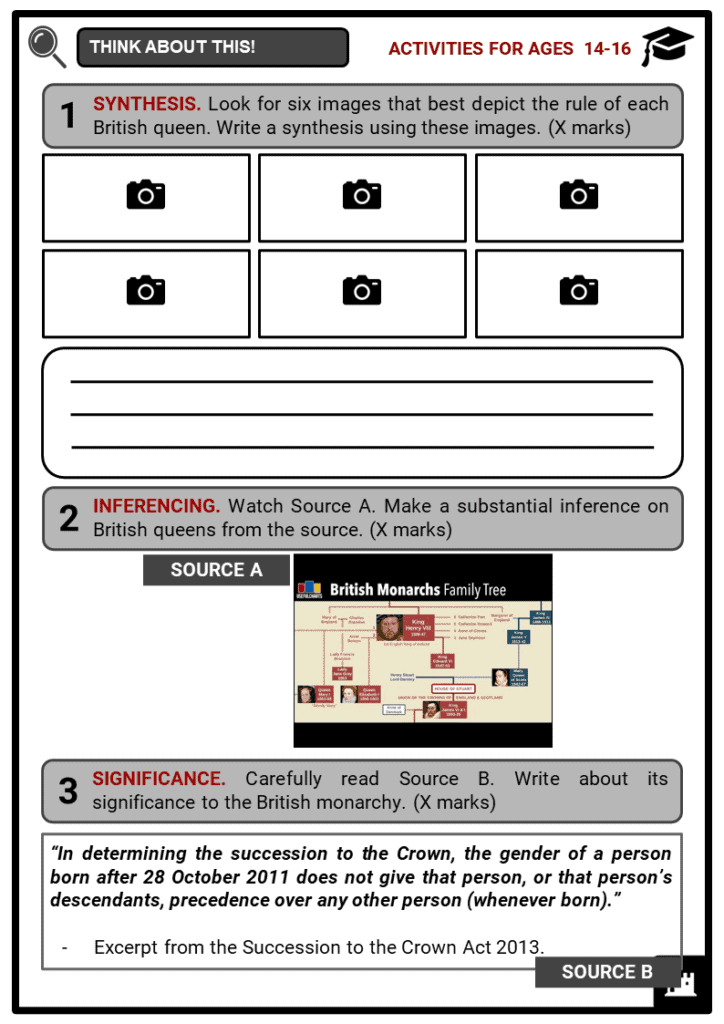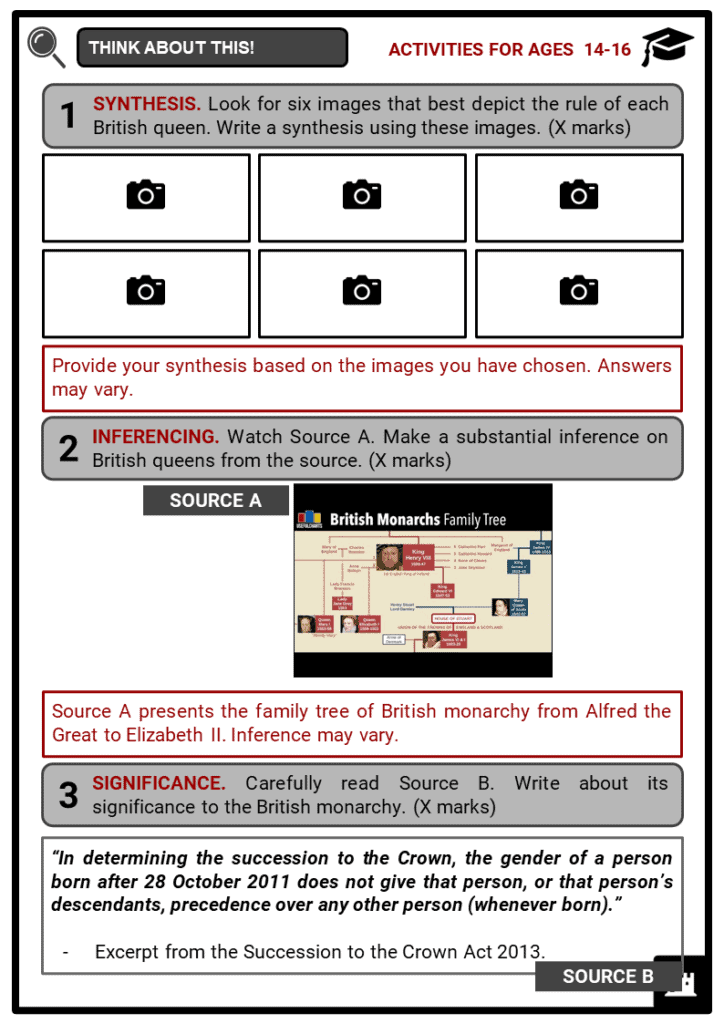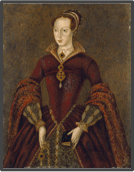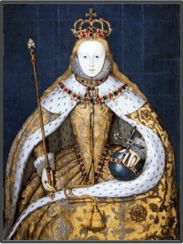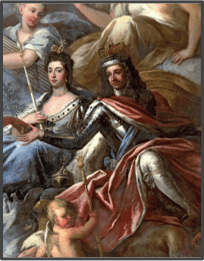Download British Queens Worksheets
Do you want to save dozens of hours in time? Get your evenings and weekends back? Be able to teach British Queens to your students?
Our worksheet bundle includes a fact file and printable worksheets and student activities. Perfect for both the classroom and homeschooling!
Table of Contents
Add a header to begin generating the table of contents
Summary
- Background of the royal succession
- Mary I (r. 1553-1558)
- Elizabeth I (r. 1558-1603)
- Mary II (r. 1689-1694)
- Anne (r. 1702-1714)
- Victoria (r. 1837-1901)
- Elizabeth II (r. 1952-present)
Key Facts And Information
Let’s know more about British Queens!
- The monarchy of England, and later the United Kingdom, has been largely dominated by men. The rule of a Queen Regnant initially came with issues of gender, marriage and succession, which sought an image that would embody the conventional roles for women.
- From the sixteenth century, there have been six recognised female sovereigns in England and the United Kingdom, namely Mary I, Elizabeth I, Mary II, Anne, Victoria and Elizabeth II. The reigns of female monarchs featured some of most significant periods in British history. To alleviate the discrimination against female heirs to the throne, the absolute primogeniture system became the basis of the line of succession with the passage of the Succession to the Crown Act 2013.
Background of the royal succession
- Male-preference primogeniture had been the basis of the lineage of succession of the monarchy in England. However, in the absence of male heirs, female rulers succeeded to the English throne. Such were the case of the few Queens Regnant in England and later the United Kingdom.
- The title of ruling monarch was passed from the king to his first-born son since the Norman Conquest of England.
- However, various factors such as war, political unrest and the inability of some monarchs to produce a suitable male heir have sometimes led to turbulent transfers in power.
- From the medieval era, there were two women whose rule in England were never recognised.
- Empress Matilda was declared the rightful heir to the English throne by her father King Henry I during the civil war known as the Anarchy.
- She fought for her right upon the usurpation of the throne by her cousin Stephen and her force even won the Battle of Lincoln in 1141.
- However, she was never crowned due to opposition of the London crowds and was instead titled Lady of the English.
- Lady Jane Grey was another female ruler in England whose rule was challenged. She was named as successor by the young King Edward VI, a problematic decision that disregarded the line of succession set by an act of Parliament.
- She reigned for nine days in 1553 until Henry VIII's first child, Mary I, won a rebellion against her.
- Whilst female heirs to the throne were discriminated against, England and later the United Kingdom have had a few reigning queens since the sixteenth century.
- In an attempt to eliminate the English common law which dictated male-preference primogeniture, parliamentary representatives of the four nations making up the United Kingdom passed the Succession to the Crown Act in 2013.
Mary I (r. 1553-1558)
- Nicknamed as Bloody Mary, Mary I was considered as the first Queen Regnant of England. Born on 18 February 1516, she was the daughter of Henry VIII and Catherine of Aragon.
- As a child, she received a thorough education in classic and modern languages, and was brought up a Catholic.
- At a young age, it was proposed that she should marry the French king Francis I.
- She was then contracted to marry the Holy Roman Emperor Charles V.
- Both marriage agreements were broken off.
- In 1525, the question of the legality of her mother’s marriage and, therefore, of her legitimacy was raised.
- The final result was the annulment in 1533 of Catherine’s marriage and the separation of mother and daughter.
- With the death of her mother, and the execution of Anne Boleyn, Mary’s situation was much improved.
- She made formal submissions to her father’s views and for the rest of his reign, had a household suited to her rank.
- When Henry VIII died in 1547, she was placed by his will next in succession to the throne after her brother Edward VI and his children.
- Though she had her difficulties under the Protestant government of Edward VI, she was not badly treated, and in 1553 succeeded him as the monarch of England, having defeated the attempt of the Duke of Northumberland to place Lady Jane Grey on the throne.
- Her restoration of the papal supremacy and the Roman Catholic faith diminished that popularity.
- Her marriage with Philip II of Spain, which incited Sir Thomas Wyatt’s rebellion, was much disliked and the severity with which she persecuted the Protestant minority aroused great discontent.
- In 1557, to aid Spain, she involved England in a war with France, and Mary I’s unpopularity was much increased by its failure and the capture of Calais, England’s last possession of the continent.
- She died childless in London on 17 November 1558.
- Her policy in ruins at home and abroad, her reign was an utter failure.
Elizabeth I (r. 1558-1603)
- Born on 7 September 1553, Elizabeth I was the second daughter of Henry VIII. Her mother, Anne Boleyn, was the king’s second wife. In order to marry Anne, the king had to divorce Catherine by breaking with the papacy. Elizabeth I may thus be regarded as the child of the English Reformation, and this role shaped her whole future. As a child, she was educated by humanist scholar Roger Ascham who regarded her as a woman of intelligence.
- The reign of her half-sister Mary I came with a threat to her life.
- Many Protestants relied on Elizabeth and when she was allegedly involved in Sir Thomas Wyatt's rebellion, she was arrested and exiled to the Tower of London.
- She was not executed, but only because of a lack of conclusive evidence against her.
- Elizabeth I succeeded to the throne on 17 November 1558.
- Her accession was enthusiastically welcomed, especially by the citizens of London and by all Protestants.
- As the queen, she proved ready to sever the English church once more from Rome and the papacy.
- Through the Act of Supremacy of 1558, she was given the title of Supreme Governor of the Church of England.
- She attempted to end the religious turmoil through the Elizabethan Religious Settlement, which shaped the theology and liturgy of the English church and was essential to the development of Anglicanism.
- Statesmen and Parliament were gravely concerned with securing the Protestant future of the country, since Elizabeth I was the last of the Tudors.
- They pressed her to marry, but the choice of a husband was so difficult and perilous that marriage proved impracticable.
- Through both choice and politics, she remained England’s Virgin Queen.
- In 1561, after the death of her husband Francis II of France, Mary, Queen of Scots returned to her native land, and the personal relations of the two queens started their complicated and controversial history.
- When Mary abdicated the Scottish throne, she attempted to find refuge in England.
- However, she was locked in the Tower of London for almost twenty years on the accusation of plotting to murder Elizabeth I.
- Mary was executed after she was implicated in the Babington Plot.
- As a result of Mary’s death, the Catholics, led by Philip II of Spain and backed by the papacy, raged war against and attempted to invade England with the objective of restoring Catholicism there.
- However, it led to the defeat of the legendary Spanish Armada, associating the reign of Elizabeth I to one of the greatest military victories in English history.
- Her reign was popularly known as the Elizabethan era, which was regarded as the height of English Renaissance.
- The period is characterised by the flourishing of English drama and literature and the seafaring prowess of English adventurers.
- On 24 March 1603, Elizabeth I died heirless after a 44-year reign, making her the last of the Tudor monarchs of England. James VI and I succeeded her marking the personal union of the Scottish and English crowns.
Mary II (r. 1689-1694)
- Mary II of the House of Stuart was the Protestant Queen of England, Scotland and Ireland who reigned jointly with her husband, William III. Born on 30 April 1662, she was the eldest daughter of James, Duke of York and Anne Hyde. Her father converted to Catholicism in the late 1660s, but Mary II and her sister Anne were raised as Protestants.
- Whilst her marriage with William, then Prince of Orange, brought her tears in the beginning, she led a contented and reserved married life in Holland for twelve years.
- The succession of her father, James II & VII, to the English throne in 1685 incited a constitutional crisis with his implementation of pro-Catholic policies.
- With the birth of James' son with his second wife, it was feared that another Catholic monarch would rule the realm.
- Mary II's husband was invited by James' opponents to lead the army to depose the king, which became known as the Glorious Revolution of 1688.
- James fled and Mary II and William III ascended the English throne on 13 February 1689.
- They signed the Bill of Rights in 1689, which prevented the succession of Catholic monarchs, secured the Protestant kingdom, reaffirmed parliament's claim to control taxation and legislation, and assured the prevention of abuses of power committed by previous Stuart monarchs.
- During their reign, the Toleration Act of 1689 was passed, which gave Protestant non-conformists, but not Catholics, freedom of worship.
- Mary II governed as regent in the absence of her husband due to military campaigns in Ireland and on the continent.
- However, she relied heavily on her husband's advice and stepped back from politics when William III was in England.
- She died childless on 28 December 1694 leaving the throne to William III.
Anne (r. 1702-1714)
- The last Stuart monarch, Anne was the queen of England from 1702 until 1707 and of Great Britain from 1707 until 1714 after the passage of the Acts of Union. She succeeded her brother-in-law, William III of Orange.
- Born on 6 February 1665, she and her sister Mary II were raised as Protestants on the instruction of their uncle, Charles II.
- She spent her childhood in France with her aunt and grandmother.
- In 1683, she married Prince George of Denmark and their union was marred by Anne's frequent miscarriages, stillbirths and the death of children in infancy.
- They had one surviving child, Prince William, Duke of Gloucester, who died at the age of eleven in 1700.
- Since Mary II and William III had no children, Anne inherited the throne in 1702.
- The War of the Spanish Succession played out during the early years of her reign.
- It was marked by a series of military victories by John Churchill, Duke of Marlborough which reinforced England's negotiating position at the end of the war.
- After the British government initiated peace talks, the 1713 Treaty of Utrecht was signed with France's recognition of Anne's title over that of James II's Catholic son, James Stuart, and confirmed England's possession of Gibraltar.
- Anne’s reign is best acknowledged for the Act of Union in 1707, which united the kingdoms of England and Scotland as a single sovereign state known as Great Britain.
- With the passage of the act, one British parliament would meet at Westminster, a common flag and coinage would be established, but Scotland would keep its own established Church and its systems of law and education.
- The development of the two party system, the Whigs and Tories, also marked Anne's reign.
- The queen was heavily influenced by her ministers and her favourites, particularly her friend Sarah Churchill, wife of the Duke of Marlborough.
- She died on 1 August 1714 and was succeeded by German Protestant Prince George, Elector of Hanover, under the Act of Settlement of 1701.
- Anne was the last of the Stuart monarchs and the first sovereign of Great Britain.
Victoria (r. 1837-1901)
- Victoria, the last of the House of Hanover, was queen of Great Britain from 1837 to 1901. Her reign was popularly known as the Victorian era, during which the English monarchy took on its modern ceremonial character.
- Born on 24 May 1819, Victoria was the only child of Prince Edward, Duke of Kent and Strathearn and Princess Victoria of Saxe-Coburg-Saalfeld.
- Her mother and her domineering comptroller, John Conroy, raised her under close supervision.
- At age eighteen and without the need for a regency, she inherited the throne in 1837.
- Her clear grasp of constitutional principles and the scope of her own prerogative was accounted to the powerful influence of her first Prime Minister, Lord Melbourne.
- In 1840, she married her first cousin Prince Albert of Saxe-Coburg and Gotha, and had four sons and five daughters.
- Their children married into royal and noble families across Europe. This earned the queen the sobriquet the grandmother of Europe.
- The death of her husband in 1861 plunged the queen into deep mourning and lengthy seclusion.
- Due to her neglect of many duties while grieving, republicanism became popular in Britain.
- However, her popularity recovered with her recognition as Empress of India, and the celebratory golden (1887) and diamond (1897) jubilees.
- She was recognised with strict standards of personal morality and had significant influence over foreign affairs implied by the marriages of her children.
- In 1901, she died on the Isle of Wight and was succeeded by her son Edward VII of the House of Saxe-Coburg and Gotha.
- Her 63-year reign was considered the longest of any female monarch in history until it was surpassed by her great-great-granddaughter, England's current Queen Elizabeth II, in September 2015.
Elizabeth II (r. 1952-present)
- Queen Elizabeth II of the House of Windsor succeeded to the British throne on 6 February 1952 at the age of 25. She is currently the longest-serving monarch in British history, whose formal duties are largely representational.
- Born on 21 April 1926, Elizabeth II is the first child of Prince Albert, Duke of York, later known as King George VI, and Lady Elizabeth Bowes-Lyon.
- Educated privately at home, her mother and the governess, Marion Crawford, oversaw her lessons focused on history, language, literature and music.
- She was initially third in the line of succession to the British throne during the reign of George V.
- When his uncle, Edward VIII, abdicated the throne causing a constitutional crisis, her father's ascension in 1936 made her the heir-presumptive.
- In 1939, she undertook duties during the Second World War, serving in the Auxiliary Territorial Service as an honorary second subaltern.
- In 1947, she married Philip, Duke of Edinburgh, a former prince of Greece and Denmark, whom she began exchanging letters with since she was thirteen.
- They have four children namely Charles, Prince of Wales; Anne, Princess Royal; Prince Andrew, Duke of York; and Prince Edward, Earl of Wessex.
- In 1952, her father died and among other duties, she became the Head of the State, Supreme Governor of the Church of England, Head of the Commonwealth, and Queen Regnant of seven independent Commonwealth countries including the United Kingdom, Canada, Australia, New Zealand, South Africa, Pakistan and Ceylon.
- Following her coronation in 1953, Elizabeth II and her husband embarked on a tour visiting thirteen countries.
- She continued to make state visits to other countries and tours of the Commonwealth, making her the most widely travelled head of state.
- Duties of Elizabeth II
- State opening of parliament
- Approval of parliamentary legislation
- Approval of secondary legislation through the privy council
- Receiving the credentials of foreign ambassadors
- Appointment of the prime minister
- Approval of official appointments
- Embarking on goodwill visits abroad and hosting foreign heads of state
- Regular confidential audiences with the prime minister
- Elizabeth II had celebrated her Silver, Golden and Diamond Jubilees in 1977, 2002 and 2012, respectively.
- Under her reign, major political changes have taken places including the devolution in the United Kingdom, accession of the United Kingdom to the European Communities, Brexit, Canadian patriation, and the decolonisation of Africa.
- The queen has occasionally faced criticisms, particularly after the breakdown of her children's marriages, her annus horribilis in 1992, the untimely death of the immensely popular Princess Diana in 1997, the resignation of her son Prince Andrew in 2019, and the stepping back from royal duties of the Duke and Duchess of Sussex in 2020.
- Despite these criticisms, Elizabeth II remains a popular royal figure in the United Kingdom.
Image sources:
- https://upload.wikimedia.org/wikipedia/commons/thumb/8/87/Streathamladyjayne.jpg/800px-Streathamladyjayne.jpg
- https://upload.wikimedia.org/wikipedia/commons/thumb/e/eb/Elizabeth_I_in_coronation_robes.jpg/800px-Elizabeth_I_in_coronation_robes.jpg
- https://upload.wikimedia.org/wikipedia/commons/b/bf/William_and_Mary.jpg

